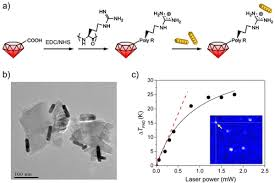TAG: GS-3: SCIENCE AND TECHNOLOGY
THE CONTEXT: Scientists at Purdue University have figured out how to levitate and spin Fluorescent Nanodiamonds (FNDs) in a vacuum.
EXPLANATION:
About Fluorescent Nanodiamonds (FNDs):
- Nanodiamonds are nanoscale diamonds, typically measuring less than 100 nanometers in diameter.
- Made from carbon nanoparticles.
- Produced under high-temperature and high-pressure conditions.
- Fluorescent nanodiamonds are a specialized type of nanodiamond that has been treated or doped with specific materials to exhibit fluorescence.
- They can emit light when exposed to certain wavelengths of light or other energy sources.

What are their applications?
- Medical Diagnostics: FNDs are used for high-resolution imaging and tracking cells over extended periods due to their non-toxic nature.
- Temperature Sensing: FNDs can measure temperatures at the microscale, making them useful for scientific experiments.
- Correlative Microscopy: Their fluorescent properties make them ideal for combining different types of imaging techniques.
- Sensor Technologies: Due to their sensitivity to acceleration and electric fields, FNDs can be used in industry sensors and gyroscopes for rotation sensing.
- Quantum Computing: FNDs doped with nitrogen can be used for quantum superposition experiments and future quantum computing applications.
Features of Fluorescent Nanodiamonds:
- Non-toxic, safe for use in biological systems.
- Structural Stability: Retain structure even in extreme conditions like high vacuum or fast rotation.
- Can be doped with other elements (e.g., nitrogen) to modify electrical or optical properties.
- Long fluorescence lifespan: Greater than 10 nanoseconds, providing stability.
Applications:
-
- Fluorescent Nanodiamonds:
- Bioimaging (e.g., cell tracking, tumor imaging)
- Quantum computing
- Sensing (e.g., temperature, magnetic fields)
- Nanodiamonds:
- Abrasives and polishing agents
- Lubricants
- Electronics (e.g., heat sinks)
- Drug delivery
- Fluorescent Nanodiamonds:
FNDs, with their stable fluorescence, quantum properties, and potential industrial applications, offer promising avenues in both theoretical research and applied fields like imaging, sensing, and quantum computing. Their recent advancements in vacuum levitation showcase their growing relevance in cutting-edge technology.
SOURCE:
Spread the Word
